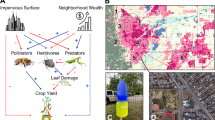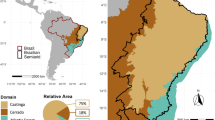Abstract
Agricultural changes such as intensification and specialization are thought to be the major source of the severe decline of farmland bird populations observed on large spatial scales and over long time spans in Europe. We studied farmers’ practices at a local level on 22 farms from the Beauce area, France, with regard to habitat preferences of grey partridge, Perdix perdix L. We focused on the study of vegetation cover because it influences grey partridge’s reproduction and survival. The results revealed a high diversity of vegetation cover over the municipal territory. This high diversity can be explained by (1) the difference in the crops cultivated by the farmers, only wheat being cultivated by all the farmers; (2) the diversity of elementary crop sequences implemented, as many as 51 having been identified; and (3) the field size, which varies from 0.5 ha to 57 ha, with 54% of fields smaller than 10 ha. Altogether, this potentially creates six different habitat types, 32% of the arable land surveyed being a likely suitable habitat for the grey partridge. We found that irrigation was the main driving factor of vegetation cover diversity. Indeed irrigation controls the farms’ crop acreage, the crop sequences and their spatial pattern and field size. Nonetheless, irrigation practices show both positive, e.g. crop diversity, and negative aspects, e.g. large fields and clutch failure, for ground-nesting birds such as the grey partridge. Based on these results, a GIS modeling of the municipal landscape related to grey partridge’s habitat requirements is possible and would allow a deeper analysis of the impact of crop diversity on grey partridge populations.
Similar content being viewed by others
References
Anderson C.Q.A., Bradbury R.B., Evans A.D. (2001) Evidence for the effects of agricultural intensification on wild bird in the UK, RSPB Research report No. 3, Sandy, UK, Royal Society for the Protection of Birds.
Aubry C., Papy F., Capillon A. (1998) Modelling decision-making processes for annual crop management, Agr. Syst. 56, 45–65.
Barbier L. (2001) Elements for a skylark (Alauda arvensis) management plan, Game Wildlife Sci. 18, 45–83.
Baudry J., Papy F. (2001) The role of landscape heterogeneity, in: the sustainability of cropping systems, in: Nösberger J., Geiger H.H., Struik P.C. (Eds.), Crop Science — Progress and Prospects, CABI Publishing, Oxon, pp. 243–259.
Beaujouan V., Durand P., Ruiz L. (2001) Modelling the effect of the spatial distribution of agricultural practices on nitrogen fluxes in rural catchments, Ecol. Model. 137, 93–105.
Bellon S., Doré T. (2005) Stability or fluctuations of crop sequences? in: Jacobsen S.E., Jensen C.R., Porter J.R. (Eds.), Proceedings of the VIII Congress of the European Society for Agronomy, 11–15 July 2004, Copenhagen, Denmark, 3 p.
Benton T.G., Bryant D.M., Cole L., Crick H.Q.P. (2002) Linking agricultural practice to insect and bird populations: a historical study over three decades, J. Appl. Ecol. 39, 673–687.
Benton T.G., Vickery J.A., Wilson J.D. (2003) Farmland biodiversity: is habitat heterogeneity the key? Trends Ecol. Evol. 18, 182–188.
BirdLife International (2004) Birds in Europe: population estimates, trends and conservation status. — BirdLife International, BirdLife Conservation Series No. 12, UK.
Birkan M., Serre D., Pelard E., Skibnienski S. (1990) Effects of irrigation on adult mortality and reproduction of gray partridge in a wheat farming system, in: Church K.E., Warner R.E., Brady Perdix S.J. (Eds.), Gray partridge and ring-necked pheasant workshop, Kansas Department of Wildlife and Parks, Emporia, KS, USA, pp. 257–271.
Bro E., Reitz F., Clobert J., Mayot P. (2000a) Nest-site selection of grey partridge (Perdix perdix) on agricultural lands in north-central France, Game Wildlife Sci. 17, 1–16.
Bro E., Reitz F., Clobert J., Mayot P. (2000b) Nesting success of grey partridges (Perdix perdix) on agricultural land in North-Central France, relation to nesting cover and predator abundance, Game Wildlife Sci. 17, 199–218.
Bro E., Reitz F., Landry P. (2005) Grey partridge population status in central northern France: spatial variability in density and 1994–2004 trend, Wildlife Biol. 11, 287–298.
Chamberlain D.E., Fuller R.J., Bunce R.G.H., Duckworth J.C., Shrubb M. (2000) Changes in the abundance of farmland birds in relation to the timing of agricultural intensification in England and Wales, J. Appl. Ecol. 37, 771–788.
Dogliotti S., Rossing W.A.H., Van Ittersum M.K. (2003) ROTAT, a tool for systematically generating crop rotations, Eur. J. Agron. 19, 239–250.
Francart C., Pivot J.M. (1998) Incidences de la structure du parcellaire sur le fonctionnement des exploitations agricoles en régions de bocage, Ingénieries EAT 14, 41–54.
Guyomarc’h J.C. (2003) Elements for a common quail (Coturnix c. coturnix) management plan, Game Wildlife Sci. 20, 1–92.
Hagemeijer W.J.M., Blair M.J. (1997) (Eds.) The EBCC atlas of European Breeding Birds, Their distribution and abundance, Poyser, Great Britain.
Joannon A., Soudière V., Papy F., Martin P. (2006) Reducing runoff by managing crop location at the catchment level: considering agronomic constraints at farm level, Land Degrad. Dev. 17, 467–478.
Leteinturier B., Herman J.L., de Longueville F., Quintin L., Oger R. (2006) Adaptation of a crop sequence indicator based on a land parcel management system, Agr. Ecosyst. Environ. 112, 324–334.
Magdoff F.R., van Es H.M. (2000) (Eds.) Building Soils for Better Crops, Handbook Series Book 4. Sustainable Agric. Network, Beltsville, MD, USA.
Maxime F., Mollet J.M., Papy F. (1995) Aide au raisonnement de l’assolement en grande culture, Cahiers Agric. 4, 351–362.
Meynier F. (2004) Analyse des relations entre les densités de perdrix grises et les caractéristiques de l’habitat en plaine de grande culture à trois échelles spatiales, Mémoire de Diplôme d’Études Approfondies, Université Pierre et Marie Curie.
Meyer B.C., Mammen K., Grabaum R. (in press) A spatially explicit model for integrating species assessment into landscape planning as exemplified by the Corn Bunting (Emberiza calandra), J. Nature Conserv. doi:10.1016/j.jnc.2007.01.001.
Morion P., Benoit M. (1990) Étude méthodologique d’un parcellaire d’exploitation agricole en tant que système, Agronomie 6, 499–508.
Newton I. (2004) The recent decline of farmland bird populations in Britain: an appraisal of causal factors and conservation actions, Ibis 146, 579–600.
Panek M. (2002) Space use, nesting sites and breeding success of grey partridge (Perdix perdix) in two agricultural management systems in western Poland, Game Wildlife Sci. 19, 313–326.
Papy F. (2001) Interdépendance des systèmes de culture dans l’exploitation, in: Malézieux E., Trébuil G., Jaegger M. (Eds.), Modélisation des agroécosystèmes et aide à la décision, INRA Éditions/CIRAD, Coll. Repères, France, pp. 51–74.
Rands M.R.W. (1985) Pesticide use on cereals and the survival of grey partridge chicks: a field experiment, J. Appl. Ecol. 22, 49–54.
Reitz F. (2003) Le statut communal de la perdrix grise et de la perdrix rouge en France: résultats d’une enquête, Faune Sauvage 258, 25–33.
Reitz F., le Goff E., Fuzeau M. (2002) Landscape selection by grey partridge (Perdix perdix) for nesting in the fields of french cereal agrosystems, Game Wildlife Sci. 19, 209–220.
Robinson R.A., Sutherland W.J. (2002) Post-war changes in arable farming and biodiversity in Great Britain, J. Appl. Ecol. 39, 157–176.
Rocamora G., Yeatman-Berthelot D. (1999) Oiseaux menacés et à surveiller en France, Liste rouge et priorité, Populations, tendances, menaces et conservation, SEOF/LPO, France, 598 p.
Serre D., Birkan M. (1985) Incidence des traitements insecticides sur les ressources alimentaires des poussins de la perdrix grise (Perdix Perdix L.) dans un agrosystème de Beauce, Gibier Faune Sauvage 4, 21–61.
SCEES (Service central des enquêtes et études statistiques du Ministère de l’agriculture et de la pêche) (2000) Recensement général agricole.
Thenail C., Baudry J. (2004) Variation of farm spatial land use pattern according to the structure of hedgerow network (bocage) landscape: a case study in northeast Brittany, Agr. Ecosyst. Environ. 101, 53–72.
Vavra P., Colman D. (2003) The analysis of UK crop allocation at the farm level: implications for supply response analysis, Agr. Syst. 76, 697–713.
Author information
Authors and Affiliations
Corresponding author
About this article
Cite this article
Joannon, A., Bro, E., Thenail, C. et al. Crop patterns and habitat preferences of the grey partridge farmland bird. Agron. Sustain. Dev. 28, 379–387 (2008). https://doi.org/10.1051/agro:2008011
Accepted:
Issue Date:
DOI: https://doi.org/10.1051/agro:2008011




